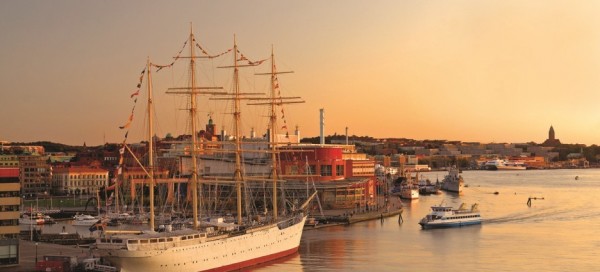Gothenburg, once a major North Sea fishing and trading port, is quietly and steadily becoming a popular destination for a cultural city break. Sweden’s second city attracts its biggest crowds in August during the week of the Gothenburg Culture Festival and for the rest of the year there’s plenty to keep curious visitors satisfied, whatever the Scandinavian weather gods may produce during their stay.
Food is a big deal in Gothenburg and as you’d expect in a city built on the back of the fishing industry, seafood features prominently in the local restaurants. If you’re in any doubt as to how seriously people take their seafood, head to Feskekörka (meaning ‘Fish Church’), a fabulous fish market that’s inside a building that looks suspiciously like a church. Feskekörka was built in the late 19th century to accommodate the ladies who, until then, had sold their men’s catches in the often freezing temperatures outside. The church theme has prevailed since its construction, so much so that weddings occasionally take place inside the building.
The Feskekörka may have been a daring design in its day, but the creations of the current generation are even more most eye-catching. The Opera House is a combination of sharp angles and glass, its shape inspired in no small part by the ships that made Gothenburg such an important Scandinavian city. Then there’s ‘The Lipstick’, a skyscraper also on the harbour, which boasts an observation deck on its top floor. The views from 86 metres up are fabulous, especially at night.
For a more traditional flavour of Swedish design, take a look at the traditional 19th century houses on and around Haga Nygata. For many years the city’s buildings were made of wood, but in an effort to prevent the all-too-frequent fires the lower floors of the city centre homes were built from stone. These old buildings now house many of Gothenburg’s trendy boutiques and galleries.
One of the more unusual and thought-provoking attractions in the city is the Museum of World Culture. The permanent and temporary exhibits in this rather stark modern building are designed to show both the similarities and uniqueness of cultures around the world. The curators make no apology for the fact that you are likely to leave the museum with more questions than answers and the frequent controversies surrounding the museum’s choice of exhibits is testament to their bold approach in presenting a topic fraught with uncertainty and disagreement.
Gothenburg is an easy city to get around on foot, but for those wanting to explore a little further the cycle hire scheme is perfect for visitors. The arrangement is similar to that in London, with a nominal fee to register and then a free unlimited number of 30 minute rentals. Where it differs is that Gothenburg is a far more bike-friendly, with dedicated cycle lanes making the experience safer and more enjoyable than the typical hair-raising ride through the streets of London.





